Vol. 10 No. 5
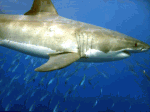 “We’ve got shark!” About the time the announcement was shouted by a crew member, the 17 divers aboard the M/V Islander had just about given up hope of discovering a geographically desirable, well sorta, great white shark destination on Isla de Guadalupe. The boatload was “skunked” the first of a three day trip, there was not a shark in sight.
“We’ve got shark!” About the time the announcement was shouted by a crew member, the 17 divers aboard the M/V Islander had just about given up hope of discovering a geographically desirable, well sorta, great white shark destination on Isla de Guadalupe. The boatload was “skunked” the first of a three day trip, there was not a shark in sight.
Several decades ago, Australian diving legends first ventured into the water with the apex predator. Blending fish guts, blood, and horsemeat, they were successful in attracting sharks to cages. Over the years, the sport grew in popularity. Hammerheads and whale sharks attracted divers to the Galapagos and Cocos Islands, south of Costa Rica, while reef and bull sharks drew divers to Florida (before the ban), the Bahamas, and other world-wide destinations.
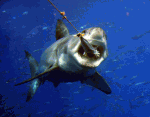 In recent years, the adventurous headed to Gansbaai, South Africa as it became the place to see great whites in action. A large population was discovered gorging on populations of newborn Cape fur seals (an estimated 60,000 of them) precariously perched on Dyer Island. The surface action, observed from the boat, was as exciting as being in the cage. About half a dozen of our Guadalupe divers had experienced close up encounters with these sharks in South Africa. They found them in greater numbers, breaching the water for seal pups—lots of exciting action. If there was a down side to South Africa; the divers found the cages small, and they missed breathing compressed air. Overall, they had an incredible adrenaline rush alone in a cage holding their breath as the metal was gnawed by a great white.
In recent years, the adventurous headed to Gansbaai, South Africa as it became the place to see great whites in action. A large population was discovered gorging on populations of newborn Cape fur seals (an estimated 60,000 of them) precariously perched on Dyer Island. The surface action, observed from the boat, was as exciting as being in the cage. About half a dozen of our Guadalupe divers had experienced close up encounters with these sharks in South Africa. They found them in greater numbers, breaching the water for seal pups—lots of exciting action. If there was a down side to South Africa; the divers found the cages small, and they missed breathing compressed air. Overall, they had an incredible adrenaline rush alone in a cage holding their breath as the metal was gnawed by a great white.
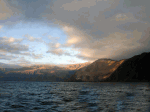 Not a scuba diver? Read on. No dive certification is required to dive with great whites. There is no buddy system, no gear other than a mask, booties, and a 7 mil wetsuit with hood. Most divers wear Lycra skins under their wetsuits. While many a novice have been introduced to great whites, it’s hard to imagine a new diver suiting up, cautiously jumping into the cage, and controlling their buoyancy in the presence of sharks.
Not a scuba diver? Read on. No dive certification is required to dive with great whites. There is no buddy system, no gear other than a mask, booties, and a 7 mil wetsuit with hood. Most divers wear Lycra skins under their wetsuits. While many a novice have been introduced to great whites, it’s hard to imagine a new diver suiting up, cautiously jumping into the cage, and controlling their buoyancy in the presence of sharks.
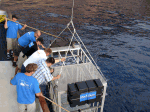 News of great whites at Isla de Guadalupe’s, 175 miles southwest of San Diego and west of Punta Eugenia on the Baja California peninsula, sounded too close to be true. It’s been happening for 10 years; with little known about their migratory habits, where they go when they depart in December. The population is estimated to be around 50, unlike the thousands inhabiting the waters in South Africa. But, San Diego is a whole lot closer than a 2-day trip across the Atlantic.
News of great whites at Isla de Guadalupe’s, 175 miles southwest of San Diego and west of Punta Eugenia on the Baja California peninsula, sounded too close to be true. It’s been happening for 10 years; with little known about their migratory habits, where they go when they depart in December. The population is estimated to be around 50, unlike the thousands inhabiting the waters in South Africa. But, San Diego is a whole lot closer than a 2-day trip across the Atlantic.
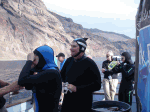 The 80′ MV/ Islander motored day and night through moderate chop on the 23 hour journey to Guadalupe. Captains Shane Slaughter and John Conniff, co-owners of the boat, spend spring and summer running “bread and butter” two to three day albacore and yellowtail trips off Baja waters. Between August and December, when the fishing season slows, they haul out two aluminum shark cages and run five day diving charters, primarily for Patric Douglas’ Absolute Adventures.
The 80′ MV/ Islander motored day and night through moderate chop on the 23 hour journey to Guadalupe. Captains Shane Slaughter and John Conniff, co-owners of the boat, spend spring and summer running “bread and butter” two to three day albacore and yellowtail trips off Baja waters. Between August and December, when the fishing season slows, they haul out two aluminum shark cages and run five day diving charters, primarily for Patric Douglas’ Absolute Adventures.
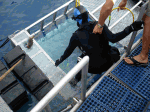 Shark master and dive instructor Luke Tipple, a cheerful Aussie, emphasized the safety concerns of Absolute Adventures. One safety procedure is to chum fish meal and drift skipjack bait away from the camera aperture or opening of the cage windows. “The sharks will come close and eye-ball you, but we don’t want them coming directly toward the cage for the bait.”
Shark master and dive instructor Luke Tipple, a cheerful Aussie, emphasized the safety concerns of Absolute Adventures. One safety procedure is to chum fish meal and drift skipjack bait away from the camera aperture or opening of the cage windows. “The sharks will come close and eye-ball you, but we don’t want them coming directly toward the cage for the bait.”
The boat is very basic. Its double and triple bunk cabins share two bathrooms. The galley/salon seats twenty-four passengers in four leather covered booths. You might say the boat is cozy, with limited privacy.
Cook Paul Grebetz did his sous-chef prep in the small open galley as though he was a gourmand. His cuisine was hearty and heavy “fisherman fare.” And, there was lots of it; usually richly topped with gravy or garlic or butter. Paul’s baking surpassed his tasty meals; he cooked a mean rhubarb and strawberry pie, fresh fruit turnovers, and all the bread.
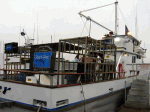 In October, 2005, Guadalupe was designated a biosphere preserve. Mexico’s goal is to preserve these magnificent creatures whose jaws sell for $10,000 a pop on EBay. According to Captain Shane, the situation had been getting out of control. Fishing boats were arriving at the island with make-shift cages; divers were swimming and photographing sharks outside cages. The government, wanting to protect the shark, put regulations in place.
In October, 2005, Guadalupe was designated a biosphere preserve. Mexico’s goal is to preserve these magnificent creatures whose jaws sell for $10,000 a pop on EBay. According to Captain Shane, the situation had been getting out of control. Fishing boats were arriving at the island with make-shift cages; divers were swimming and photographing sharks outside cages. The government, wanting to protect the shark, put regulations in place.
Just after sunrise, the ocean settled as the island came into view. The island is a geological wonder, a starkly beautiful landscape. Its 98 square miles (22 mile long) is environmentally isolated, surrounded by deep water. Dramatic vistas along the north end of the island rises rise to 4200 feet, high enough to create its own weather system. Isolated areas of colorful red volcanic layers are visually comparable to the Grand Canyon.
Guadalupe island pine and cypress trees condense cloud moisture into fresh water springs, supporting a community of plants along the top ridge of the island. After goats were introduced by sealers and failed ranching enterprises, the island was wiped clean of most vegetation.
Around every shoreline bend is a unique sheer lava rock formation. Some are colorful; others with pitted or blanched cliffs. Fur seals perched on top of large boulder rock falls, while elephant seals (both with pups) slumbered on beaches. The place is somewhat reminiscent of the Galapagos.
The crossing had seemed like an endless rock and roll, with a half dozen of the divers suffering various degrees of seasickness. On arrival, the group came alive with anticipation. Supposedly, every boat and captain has a different name for Guadalupe’s bays. “We call this North Bay.” Anchored at the site of a former federal prison, the area is currently a Mexican research station. They are attempting to measure shark movement using triangulated buoy transponders.
Captain Shane and the four deck crew deployed the 4 by 10 feet wide cages with an electronic boom lowering them three feet below the surface and a similar distance away from the stern. A pump chummed fish meal into the water quickly attracting schools of scad mackerel and top smelt. Two five to six pound skipjack were floated on buoys off each side of the hinged adjacent cages.
Four divers rotated in hour-long shifts in each cage. Hookah lines filter compressed air through ScubaPro regulators to divers weighted with harness-type vests. Pocketed with 35 to 40 pounds of weight, negative buoyancy enables divers to stand or sit on the bottom of the cage. Circling the perimeter of the cage was a two foot camera aperture opening.
Three taps on the cage was the signal for rotation time. The procedure to get out the cage was awkward for anyone without very long legs. After handing cameras to the crew, the exit required climbing a metal ladder then precariously balancing on the top of the cage. A wrist grab, from the crew was required. Luke warned “Don’t try! The worse case scenario is to fall off the cage into 200 feet of water with 40 pounds of negative buoyancy weight pulling you into the abyss.”
Swimming gracefully like a whale shark, a 15-foot female, her neck covered with mating scars, circled the boat. Then a smaller male appeared. The adrenaline rushed, but the sharks appeared to have little interest. They continued circling except when one launched into high gear to grab a dangling skipjack. When sharks were around, the hour seemed like minutes. Fortunately, on the second day, everyone enjoyed the thrill of seeing four great whites.
On our final day, viewing, as usual, began at 7:30. A single great white appeared around 10 in the morning. He swam aimlessly under the boat at a depth just out of camera focus. But, he stayed with us for most of the day occasionally teasing us with a nearby swim by.
If you are keen on being in the water with this apex predator, and aren’t keen on traveling as far as South Africa, Guadalupe is the place to go. There may not be as many great whites, but one will do.
If you go:
Patric Douglas of Absolute Adventures runs about ten 5-day charters through the late summer and early fall. The trip costs $2500 and an overnight stay in San Diego is required the night before and after the trip. The ship has a 5-hour window for a late afternoon or evening return. The Holiday Inn Bayside offers a free shuttle from and to the airport. Special shark diver rates are around $100.00 a night. The hotel is walking distance to the dock. Many airlines provide service to San Diego including Southwest, America West, American, Delta, United, and others. Divers can rent dive gear and wet suits from the Martin Graf Dive School for $50-100. They will pick up and deliver the gear to the boat. Rental arrangements are required in advance.
www.sharkdiver.com
415.235.9410 or 888.405.3268
